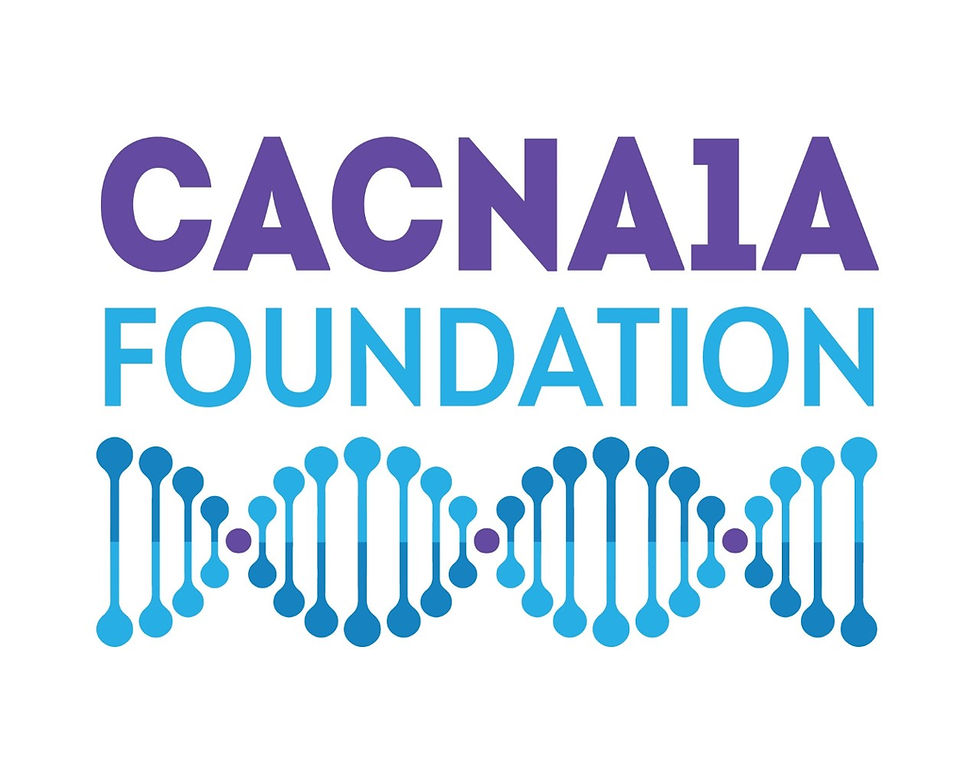Get to Know CACNA1A Foundation
- REN

- Oct 31, 2020
- 4 min read
Updated: Apr 25, 2021
About CACNA1A
Mutations in the CACNA1A gene are associated with early-onset epileptic encephalopathy. The presentation is diverse and includes epileptic encephalopathy, generalized epilepsy, absence seizures, focal seizures with or without generalized tonic-clonic seizures, and febrile seizures. The CACNA1A gene is located on chromosome 19p13 and encodes the alpha1 subunit of the CaV2.1 P/Q-type voltage-gated calcium channel that is widely expressed throughout the central nervous system. Calcium channels are important for the movement of calcium ions into many of our body’s cells, which in turn activates several important processes. The CACNA1A protein forms the pore or hole through which the ions move. These channels are essential for communication between nerve cells in the brain and possibly their survival and ability to change. CACNA1A has a specific pattern of activity in different parts of the brain, especially during development, so changes to its function may cause significant neurological difficulties. Variants result in the production of a protein that has either a gain of function (GOF) or loss of function (LOF). In both cases, the CACNA1A protein does not function as expected and, therefore, the movement of calcium ions through calcium channels does not occur as expected. In 1997 and 1998, mutations in the CACNA1A gene were found to be responsible for three disorders with autosomal dominant inheritance: Episodic ataxia 2 (EA2), familial hemiplegic migraine type 1 (FHM1), and spinocerebellar ataxia type 6 (SCA6). In 2001 it was discovered that epilepsy is associated with dysfunction of the brain P/Q-type voltage-gated Ca(2+) channel. We now know that CACNA1A causes epilepsy in many patients, regardless of whether their variant is a GOF or LOF. It has been estimated that CACNA1A variants occur in 1/11,723 births.
CACNA1A Syndrome Clinical Features
Variations on the CACNA1A gene can cause various symptoms that may include epilepsy, congenital, episodic and spinocerebellar ataxias, cerebellar atrophy, migraines, hemiplegic migraines, eye movement disorders, developmental delay, intellectual disability, and hypotonia. CACNA1A is a spectrum disease, with not all variants having the same symptoms and significant variation in each symptom’s severity. One of our biggest challenges, as we try to move research forward, is this great variability in symptoms and that our group includes those with both GOF and LOF mutations. Children have global developmental delays and require multiple types of therapies. They see specialists that may include a neurologist, epileptologist, neuro-ophthalmologist, geneticist, and developmental pediatrician. As there are currently no CACNA1A-specific treatment options, our families experiment with various medications in an attempt to alleviate symptoms. It is a very stressful process for children and their families. CACNA1A-related disorders can cause serious health emergencies, including status epilepticus with respiratory distress and severe hemiplegic migraines. Extended hospitalizations due to these emergencies are not uncommon. Those with a CACNA1A-related Developmental and Epileptic Encephalopathy diagnosis often require a detailed at home seizure emergency rescue plan. Prophylactic treatment is recommended for hemiplegic migraines. Like many other DEE families, many in our community have to collaborate with their care team for an adequate plan to reduce the risk of emergencies

Get to Know CACNA1A
The CACNA1A Foundation, Inc. was founded in January 2020 when three families connected over their shared desire and sense of urgency to find better treatment options for their affected children. Our mission is to support families and to raise funds for research. We are focused specifically on translational research that will find new treatments and, hopefully, a cure for CACNA1A variants. As a rare disease group, we are stronger together. While based in the USA, we support families worldwide and collaborate with researchers both nationally and internationally.

I am especially proud of ...
I am most proud of the fast pace at which we have grown. We received our 501(c)(3) nonprofit status in June 2020 and launched our website in July 2020. We opened our Grant Program three months later, inviting scientists to bring us their very best research ideas that to move us closer to CACNA1A clinical trials. As CACNA1A is often neurodegenerative, many CACNA1A families watch their children decline before their eyes, and the clock is ticking to find treatment options. We feel time slipping away with our children and are working day and night to keep the promise of finding new treatments and a cure with a sense of urgency to our community.
Excited to REN because...
REN has already helped our constituents by connecting us with other rare disease group leaders who have walked this road before us. They have all passed on mistakes they’ve made in starting an organization so that we don’t do the same. Discussions regarding patient registries, how to best utilize our Scientific Advisory Board, and how to better connect with our community have made our journey more successful. We are grateful for the relationships we have formed since joining REN. We are excited to continue learning from other leaders and to collaborating with them to improve the quality of life and care of those living with epilepsy. Finally, we look forward to sharing our experiences and passing on our wisdom with newer groups one day.
My journey and motivation...

My daughter, Ireland, is my motivation to find a cure for CACNA1A. I have always wanted to be a mother, and Ireland (and her sister) have made all my dreams come true. On her great days, Ireland loves summers at the pool, dance parties and going to “school” (therapy). On days that CACNA1A turns our world upside down, Ireland suffers from intractable epilepsy with frequent status epilepticus and horrible medication side effects. I am very encouraged by gene therapy and other treatment possibilities on the horizon and am dedicated to pushing CACNA1A research forward to give Ireland a brighter future.
By Shanna Tolbert, Co-Founder & Treasurer











Comments